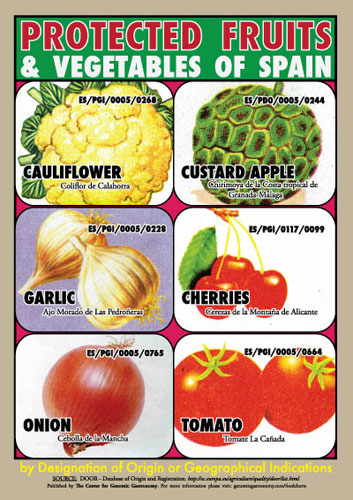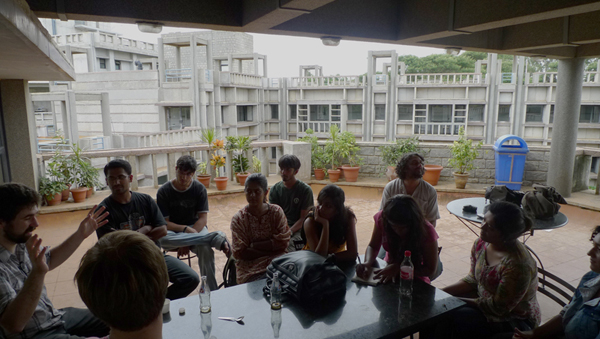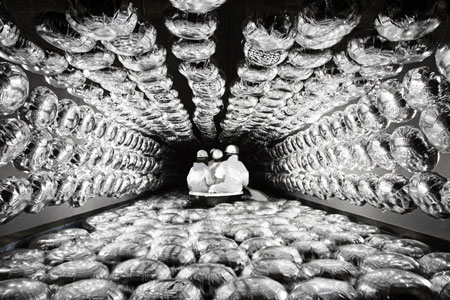This past semester I taught Art & Science at the Pacific Northwest College of Art’s Intermedia department. I created a small in-class assignment to introduce the idea of creatively engaging the history of Genetically Engineered food. Students were asked to examine the USDA’s database of Field Test of GM Crops / Petition for Deregulation and write recipes using the plants they found in the database. I originally became aware of this University-hosted database through the the Center for Post Natural History’s Permitted Habitats project. The European Union’s equivalent database is available here.
I ask students to use the lens of cuisine to investigate transgenic food (a.k.a., GMOs, AgBiotech, Genetically Engineered food) because it allows them to ask very important “stupid” questions that rarely come into the debate around transgenic food such as:
- “How does this transgenic varietal TASTE compared to other varietals?” – or simply:
- “What varietal of plant has been transgenically altered and what do we call it?” (See: Fish Tomato)
Most of the students in my class were well versed in the popular arguments for and against transgenic foods before coming into the class, and we read Chapter 5, 6, 7 & 8 from Stewart Brand’s Whole Earth Discipline. I also shared some of the research I have done with the Center for Genomic Gastronomy in the form of a recent 5-minute talk and the first episode of the Glowing Sushi Cooking Show.
Looking at primary source documents that are rarely referred to in the public discourse gave students a prompt for asking new and strange questions about the artifacts, individuals and institutions of emerging agricultural biotechnologies. One of the things we learned as a class is that much of the paper trail surrounding emerging agricultural technologies such as genetically engineered crops, is not written to be legible to the layperson. Even if one spends the time to wade through the scientific and business jargon, the supposed purpose and cultural narrative of a plant is very hard to determine.
The records list the Institution who created the organism, the plant name, the genes inserted (called transgenes if they have been isolated form another organism) , and the phenotypic (the physical expression of genetic characteristics) change in the plant species.
Sometimes the phenotypic change is explained in jargon or simply unclear, in other cases, even if the phenotypical change is clear (see: sweet-cucumber), it is unclear what the benefit that change is to the land, animal, farmer, processor or consumer.
Students were also interested/frustrated in the seeming ubiquity of the acronym C.B.I. or “Confidential Business Information” in much of our research. It is our understanding as a class (though we hope we are wrong!) that once a company receives approval from the USDA for field testing a genetically modified plant, they are not required to make public the results of that field test. So on top of all the other lacks of transparency or clarity, citizens don’t know whether the genetically modified plant was efficacious. This lead us to a discussion about what it means to practice science (as opposed to engineering, biohacking, business or other practices), and whether the verifiability and repeatability of data are requirements for a process to be labeled “Science”.
Many of the students from the Art & Science class continue to be skeptical of the overall benefits of transgenic agricultural technologies compared to other food system solutions, especially ones that take a holistic and non-reductionist approach to food and health. Dealing with the primary source documents gave a much more nuanced view of the history and politics of transgenic food in the U.S. and the E.U.
I would be excited to talk to other educators / citizen groups who have ideas for accessing, analyzing and translating this rich collection of data that rarely sees the light of day. Recipe-writing exercises around this database provided a way of teaching research methods and database access for any students interested in the curiously invisible cultural history of agricultural biotechnology.
And now on to the Recipes:
(SUPER SWEET) PINEAPPLE CRISP by Elizabeth Armstrong
Have you ever wondered why pineapple wasn’t any sweeter? Well now you don’t have to. Thanks to Hawaii University we now have genetically engineered pineapples that will have your dentist smiling! This simple recipe will satisfy even the sweetest sweet tooth. Make it on Valentines Day to share with your sweetie. Pair with a fine cognac.
INGREDIENTS:
One GE Hawaiian Pineapple [97-220-04n] (Diced)
One Cup Corn Syrup
One Cup (package) Maple and Brown Sugar Quaker Instant Oatmeal
Two Cups Salted butter
Half Cup Raw Sugar
Half Cup Brown Sugar
INSTRUCTIONS
Preheat oven to 350°. Fold in pineapple and corn syrup, set aside. Combine oatmeal, butter and raw sugar. Place pineapple mixture in the bottom of a non-stick 9×9 baking dish. Layer the oatmeal mix on top of the pineapple. Sprinkle brown sugar over the top to caramelize. Bake for 25mins. Serve warm with a sweet cream ice cream.
CORRESPONDENCE
Email to Professor David A. Christopher: Professor of Biotechnology, University of Hawaii
Hello Mr. Christopher,
I am an art student attending the Pacific Northwest College of Art, in Portland Oregon. I am currently enrolled in an Art an Science class in which we are looking into genetically engineered food.
While looking at the Information Systems for Biotechnology web page I came across a pineapple in which in 1997 the University of Hawaii genetically engineered, amongst other things, to be sweeter. The bp number is 97-220-04n. I was curious what the benefit of making this fruit, which seems sweet in itself, sweeter would be. We guessed in class that it could be about ripening times or perhaps about attracting other organisms to aid in some way.
If you have the time I would love to understand more about this.
Thank you for your consideration,
Elizabeth Armstrong
OVERLY AROMATIC ORANGE MARMALADE by ArtStudentPNCA
Orange Marmalade that you smell before you taste. Create a delicious and aromatic Sweet orange with the help transgenic oranges that have endogenous content of limonene which are altered by the over expression of the limonene synthase gene from citrus in sense or antisense. As a consequence of this genetic modification, fruit aroma has been modified and maximized for your enjoyment in the transgenic sweet orange. This will modify their possible new interaction with herbivore insects such as Ceratitis Capitata (Mediterranean fruit fly), and attraction of predators of herbivores, so you better make extra to feed all those birds!
INGREDIENTS
12 Highly aromatic medium Sweet Oranges, approximately 3 pounds, 1 pound smell
Sweet Orange B/ES/08/02 (More Information)
4 Cups of non-smelling water
1 medium scented lemon and one regular scented lemon
5 Cups granulated sugar, smell strength to your liken
PREPARATION
Wash the highly aromatic oranges once or twice and dry them with a clean unscented kitchen towel so as not to contaminate. Cut the oranges into equal aromatic halves and using a juice- maker squeeze out the juice. You get approximately 2 cups of orange juice and 1 cup aroma from 12 oranges.
Keep aside the seeds and the orange membranes to make pectin. Using a spoon, remove the pulp from each juiced orange. Using a sharp knife julienne the orange peel. You would get approximately 4 cups of peel and 2 cups aroma.
Squeeze out the juice from the regular scented lemon and add it to the orange juice. Cut the medium aromatic lemon lengthwise and remove the seeds and the inner membrane. Now cut the regular scented lemon into small triangular pieces In a muslin jelly bag, put the seeds of oranges and lemons along with their membrane and tie it tightly so to loose as little aroma as possible.
In a thick-bottomed vessel/pan, pour the combination of lemon and orange juice. Add water and the pieces of Medium scented lemon and highly aromatic sweet oranges. Now slowly drop the muslin jelly bag into the pan and allow it to boil for ½ hour. Remove the muslin bag and allow it to cool.
You would have approximately 4 to 5 cups of juice and 3 to 4 cups aroma by now. To this add 4 cups of sugar and mix well and reduce the flame. By now the muslin bag would have cooled down. Squeeze out the juice from it but not the aroma. This is known as pectin. Add this to the orange mixture.
Bring the flame of the orange mixture and aroma to medium and slowly increase to boiling consistency. Let it boil for 30 to 45 minutes. Now you should have the consistency of a jelly.
Fill a clean glass with water and drop a spoon of marmalade into it. if it does not dissolve in the water, it means the marmalade is ready. You could use a candy thermometer also.
Cool it well before canning. Serve in a well sterilized area so as to get affect of aroma, tastes very good on scones and toast.
EVERYTHING & NOTHING CORN AND AVACADO ARANCINI by Bob Fish
Prep time 2 hours
Cook time 8 minutes
Serves 8
INGREDIENTS
2 c. Ventria Bioscience Rice (10-183-101r)
1 ½ c. Hot Water
1 ½ c. Hot chicken Broth
1 c. Dry white wine
1 tbsp Monsanto Canola Oil (06-039-10n)
1 tbsp Pioneer Hi-Bred International Inc. Vegetable oil (10-273-103n)
1 tbsp Unsalted Butter
2 c. Pioneer Hi-Bred International Inc. Corn Kernels (cooked) (10-052-101n)
2 University of Florida Avocados peeled and cubed to 1/4 in. (03-008-02n)
1 lb. Fresh Mozzarella
1 c. Pioneer Hi-Bred International Inc. Corn meal (10-052-101n)
2 c. Monsanto Canola Oil (06-039-10n)
2 c. Pioneer Hi-Bred International Inc. Vegetable oil (10-273-103n)
Salt and Fresh Ground Pepper to taste
DIRECTIONS
Heat oil mixture and butter over medium in a large skillet. When butter is completely melted, add rice and cook until a light golden brown. Adjust heat to low and add all of the wine and equal parts water and broth, enough to fully cover rice stir occasionally. As the rice absorbs the liquids continue to add equal parts broth and water slowly until all liquids are used. Continue to cook and stir until all liquid is absorbed. When finished add salt and fresh ground pepper to taste, stir, then remove rice from pan on to a flat surface and cool for about 1 hour. When cool the rice should be fairly sticky. Mix in corn and avocado being sure not to mash the avocado too much. Separate mozzarella into 1 oz. balls. Shape rice into balls about 2 inches in diameter.
Stuff balls with mozzarella being sure to not leave any cheese uncovered. Roll balls in corn meal until covered. Heat the 4 cups oil mixture in a 1 1/2-quart pot or in a fryer. When oil is hot approximately 350 degrees gently drop balls into pot. Fry for 6-8 minutes or until golden brown. Top with salsa roja and serve.
CHEF’S NOTE
There are many different kinds of GE rice on the market right now and there is no delineation of what type or strain of rice it is (short gain, long grain, etc.) so for this recipe there are different ways to go about it. If you are able to find a GE Arborio rice (which is an itallian short-grain rice) I would suggest using that but the Ventria Bioscience rice should be a workable substitute. You must be sure to cook it until it is the consistency of oatmeal. This recipe while having a very small variety of ingredients has a very wide variety of nutritional valueThis recipe is best when served with Salsa Roja.
QUICK ENERGY POTATO BARS (with no Amylase Potatoes) by Becca Heitz
Amylase is a difficult to digest carbohydrate, these potatoes deliver easy to digest carbohydrates for a quick energy boost.
1 cup quick cooking rolled oats
1/2 cup raw unsalted sunflower seeds
1/2 cup toasted wheat germ
1/4 cup potato flour made with no amylase potatoes (B/NL/04/04)
1/2 cup dried apricots
1/2 cup raw almonds
1/2 cup raisins
1/2 cup pitted dried dates
1/2 cup powdered nonfat dry milk
1/2 teaspoon ground cinnamon
1/3 cup pure maple syrup
2 large eggs
DIRECTIONS
Preheat the oven to 350 degrees F. Coat a 9 by 13- inch baking pan with cooking spray. Place all ingredients except the syrup and eggs in a food processor and pulse until the mixture is finely chopped. Add the syrup and eggs and pulse until the mixture is well combined.
Transfer to the baking pan and spread evenly. Bake until just done, about 20 minutes. Cut into 20 squares.
COLORFUL CANDIED GERANIUMS (with Color Altered Pelargoniums) by Becca Heitz
Edible geraniums (pelargoniums) have been engineered to be especially colorful, try them in salads, or candy them and use them to decorate deserts.
1/4 cup egg whites, beaten
1/4 cup egg whites, beaten
2 cups geraniums (05-123-01n) [Notice the CBI in the report]
DIRECTIONS
Clean and dry your flowers or petals. Use a brush to paint a thin layer of egg white onto each side of the flower petals or blossoms. Gently place them into a shallow bowl of superfine sugar and sprinkle sugar over them to coat. Remove from the bowl, and place them on a piece of waxed paper. Sprinkle some more of the sugar over them. Al- low them to dry until stiff, about 8 hours. Store at room temperature in an airtight container until using.
KENTUCKY FRIED TOFU (with Increased Fatty Acids [University of Kentucky]) by Becca Heitz
This is the vegetarian version of a Southern favorite. The tofu has added fatty acids making it more similar nutritionally to meat.
INGREDIENTS
Canola oil
3 pounds extra firm tofu (08-116-107n)
Salt
All-purpose flour, for dredging
DIRECTIONS
Heat 1/2-inch of oil in a large skillet over medium heat. Season tofu with salt and cover in flour (use a large plastic resealable bag). Place tofu in oil and brown on all sides evenly, about 4 to 5 minutes per side, or until chicken is fully cooked through. Remove to a paper towel and refrigerate until cold. This is best made 1 day in advance.
This post is part of Food for Thinkers, a week-long series organized by Nicola Twilley for GOOD’s newly-launched Food hub. On Twitter, follow #foodforthinkers.
























